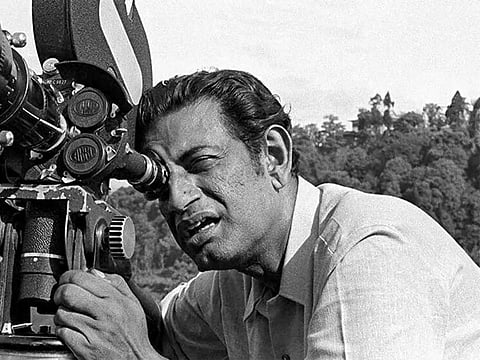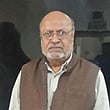100 years of Satyajit Ray: How relevant is the maestro today?
The humanism of his films is being missed all the more, so is his creative versatility

Also In This Package
Kolkata: ‘‘We all need to see the films of Satyajit Ray and re-see them, again and again. Taken all together, they’re one of our greatest treasures.’’
- Martin Scorsese
‘‘Not to have seen the cinema of Ray means existing in the world without seeing the sun or the moon.’’
- Akira Kurosawa
One is an American master and the maker of timeless Hollywood classics like ‘Taxi Driver’ or ‘Goodfellas,’ the other the Japanese auteur who is regarded as one of the most influential filmmakers of the 20th century. The sense of respect and admiration for Ray, the man who was responsible for taking Indian cinema to the global audience, was one of the few factors they would have had in common.
It’s a pity that the Covid-19 pandemic, like so many other things in our lives, have deprived his family and Kolkata - his own city - from celebrating his 100th birth anniversary on Sunday (May 2). The fact that it’s also the day for counting of votes after a volatile, protracted assembly elections in West Bengal over March-April, means the opportunities for his retrospectives, appraisals in TV talk shows and what have you - will have to wait.
Ray, a true Renaissance Man of Bengal and who himself shunned any over-the-top idolatry, would not have been possibly too bothered with the muted celebrations like commemorative issues of some serious magazines or re-runs of some of his films in Prime Time. What would possibly have been of more consequence to him is that how relevant has he remained as he turned 100 - 29 years after his passing away in 1992 ? It’s a question worth pondering in this era of social media and instant gratification - which now sees frontline filmmakers of his own Bengali film industry retweet words of sycophancy about their films.
Despite the niche that Ray had managed to carve for himself among the international audience - and the spell that he had cast on the regional filmmakers who followed him - the irony was he could not possibly exert a pan-Indian influence for his reluctance to make more Hindi films. In fact, he made only one feature film in Hindi, Shatranj ke Khiladi in 1977 and a short TV film Sadgati - the latter would have worked very well in the OTT format today. It was not for lack of financiers, but his own decision to shy away in working in a language that he was not comfortable with.
There was a mixed response to his craft - as well as for the ‘Holy Trinity’ of Ray, Mrinal Sen and Ritwik Ghatak on the whole - from the mainstream Bollywood industry of his times. There are some apocryphal stories which does the rounds like a comment by Nargis Dutt, mother of Sanjay Dutt, who said Ray peddled Indian poverty abroad to win awards - while on the other hand of the spectrum - the ‘new wave’ which Hindi cinema witnessed from late Seventies to Eighties had strongly borne the Ray legacy.
‘‘Satyajit Ray was, of course, the most important Indian filmmaker. I don’t think there has been another of that quality since,” said Shyam Benegal at the opening of a Ray Retrospective in 2017 in Israel. “But Ray also occupies historically a very interesting position in Indian cinema because when you talk about Indian films, you always say this is something before Ray and this is something after Ray,” said Benegal, the pioneer of arthouse Hindi cinema with his memorable creations, Ankur, Nishant and Manthan - films which gave birth to one-in-a-generation performers like Naseeruddin Shah, Om Puri, Shabana Azmi or the late Smita Patil.
Ray also occupies historically a very interesting position in Indian cinema because when you talk about Indian films, you always say this is something before Ray and this is something after Ray

The impression that he left on his next generation of filmmakers in Bengal - from Buddhadeb Dasgupta, Gautam Ghose, actor-turned-director Aparna Sen (who made her debut as a teenager in Teen Kanya, one of Ray’s early creations) to the late Rituparno Ghosh, Kaushik Ganguly or Srijit Mukherjee - is indelible. There are a number of films which have been straight take-offs on Rays’s masterpieces like Abar Aranye (In the forests again) by Ghosh on Ray’s Aranyer Dinratri, Mukherjee’s Autograph on Nayak (The Hero) or Arindam Sil’s Aborto (The Whirlpool) on Simabaddha (Company Limited).
‘‘It’s unfortunate that his 100th year and all that we planned to do around it, was washed away in the pandemic. But Satyajit Ray’s work is more relevant today than ever. His humanism is missed today when our enemy is in our living room in the form of social media,’’ remarked Gautam Ghose, the maker of Naseeruddin Shah-Shabana Azmi starrer ‘Paar’, ‘Padma Nadir Majhi’ and 'Moner Manush.'
Multi-tasking? Ray did it much before the term was coined
A film director, writer, illustrator, graphic designer and music composer, Ray was born on May 2, 1921 into the illustrious Ray (earlier Raychaudhuri) family which was renowned in the 20th century Kolkata (then Calcutta) for their contributions to art, literature, music as well as business of printing technology. As the son of Sukumar Ray and Suprabha Ray, he inherited the creative genes of his father and grandfather Upendrakishore. After graduating from the Presidency College of Calcutta, he enrolled into the Visva Bharati University founded by Rabindranath Tagore. During his stint here, Ray’s creative faculties were enriched by the exposure to different nuances of fine arts. His formative years were spent in Shantiniketan under the guidance of Tagore himself and it was here that he came in contact with the several stalwarts of his age.
Ray always maintained that his tutelage under Nandalal Bose and Benod Behari Mukherjee enriched his creative faculties to a great extent. He started his career as a junior visualiser at the British advertising agency D.J. Keymer, and by his own admission he held this profession as a graphic artist very close to his heart.
It was in 1943 that he was invited by a senior colleague from D.J. Keymer to work with Signet Press. It was Ray who designed the covers of such books as Aam Aatir Bhepu (a children’s edition of Bibhuti Bhusan Banerjee’s Pather Panchali), Man-Eaters of Kumaon(Kumaomer Manuskheko Bagh, in Bengali translation) by Jim Corbett and ‘The Discovery of India’ by Jawahar Lal Nehru. It was around this time that Ray developed a passion for filmmaking, when on having been sent to London on an assignment he got an opportunity to see several international films of which Neo-realist Vittorio De Sica’s ‘Ladri di biciclette’ or ‘Bicycle Thieves’ (1948) had a profound impact on him. The influence of these films, alongwith the story-telling of Hollywood, left a lasting impact on his style.
Filmmaking career
Pather Panchali (Song of the Little Road), Ray’s pathbreaking debut film, revolutionised the idea of filmmaking in India with its release in 1955. Aparajito (The Unvanquished) and Apur Sansar (The World of Apu) made up this trilogy that received phenomenal critical acclaim and was received globally as the trilogy that was set to redefine the very idea of filmmaking. Ray was praised for his cinematic brilliance and awards seem to pour in by the dozen.
Ray has spoken about his craft and philosophy in several books and essays, but a quote from one of his mid-life interviews would be relevant here. “I had a western education, I studied English, and only over the last ten years, I have found myself more and more going back to the history of my country, my people, my past, my culture...”
Writing career
A celebrated fiction writer, Ray was one of precursors of detective and science fiction in Bengali literature. Creating the sharp sleuth, Feluda, Ray ensured that he gave children an occasion to celebrate their childhood, their imaginative and fertile minds and at the same time provided spine-chilling entertainment through these Feluda thrillers. He also brought onto the literary scene, the eccentric genius Shonku, who by virtue of his endearing eccentricity and keen scientific acumen, redefined the genre of science fiction.
Ray published several works on film criticism and was also instrumental in carrying forward the legacy of his family’s famous Bengali children’s magazine Sandesh. In 1983, Ray’s health deteriorated due to heart complications - a handicap which curbed his movement and restricted him to shoot only indoor drama for nearly last nine years of his life.
He received an honorary Oscar in his death bed and shortly afterwards breathed his last on April 23, 1992.
Take a bow, Sir!
The Ray Filmography
Pather Panchali (Song of the Road) 1955
Aparajito (The Unvanquished) 1956
Paras Pathar (The Philosopher’s Stone) 1958
Jalshaghar (The Music Room) 1958
Apur Sansar (The World of Apu) 1959
Devi (The Goddess) 1960
Teen Kanya (Three Daughters) 1961
Kanchenjungha 1962
Abhijan (The Expedition) 1962
Mahanagar (The Big City) 1963
Charulata (The Lonely Wife) 1964
Kapurush-O-Mahapurush (The Coward and the Holy Man) 1965
Nayak (The Hero) 1966
Chiriakhana (The Zoo) 1967
Goopy Gyne Bagha Byne (The Adventures of Goopy and Bagha) 1968
Aranyer Dinratri (Days and Nights in the Forest) 1969
Pratidwandi (The Adversary) 1970
Seemabaddha (The Company Limited) 1971
Ashani Sanket (Distant Thunder) 1973
Sonar Kella (The Golden Fortress) 1974
Jana Aranya (The Middle Man) 1975
Shatranj Ke Khiladi (The Chess Players) 1977
Joy Baba Felunath (The Elephant God) 1978
Hirak Rajar Deshe (The Kingdom of Diamonds) 1980
Ghare Baire (The Home and the World) 1984
Ganashatru (An Enemy of the People) 1987
Shakha Prasakha (Branches of a Tree) 1990
Agantuk (The Stranger) 1991
Documentary
Rabindranath (1961)
Sikkim (1971)
The Inner Eye (1972)
Bala (1975)
Sukumar Roy (1987)
Short film
Two (1964)
Pikoo (1980)
Sadgati (Deliverance) 1981
Major awards won by Ray
1958: Padmashree, India
1965: Padmabhushan, India
1967: Magsaysay Award, Philippines
1971: Star of Yugoslavia
1973: Doctor of Letters, Delhi University
1974: D.Litt, Royal College of Arts, London
1976: Padma Vibhushan, India
1978: D.Litt, Oxford University, Special Award, Berlin Film Festival; Deshikottam, Visva Bharati University, India
1979: Special Award, Moscow Film Festival
1980: D.Litt, Burdwan University; D.Litt, Jadavpur University
1981: Doctorate, Benaras Hindu University, India; D.Litt, North Bengal University, India
1982: Hommage a’ Satyajit Ray, Cannes Film Festival; Viyasagar Award, Government of West Bengal
1983: Fellowship, British Film Institute
1985: D.Litt, Calcutta University; Dadasaheb Phalke Award, India; Soviet Land Nehru Award, Soviet Union
1986: Fellowship, Sangeet Natak Academy, India
1987: Legion d’ Honneur, France; D.Litt, Rabindra Bharati University, India
1992: Academy Award for Lifetime Achievement, USA
Akira Kurosawa Award for Lifetime Achievement Award, San Francisco International Film Festival
Bharat Ratna, India
Sign up for the Daily Briefing
Get the latest news and updates straight to your inbox








